-
Digestive Processes
-Ingestion
-Digestion
-Absorption
-Egestion
-
Ingestion
Taking of food and liquid into the mouth
-
Digestion
Breakdown of food into small molecules that can cross plasma membranes
-
Absorption
Nutrient molecules are moved into the bloodstream
-
Egestion
Discharging undigested material
-
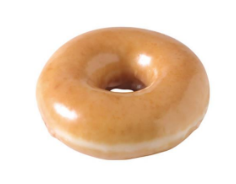
Path of Digestion-whole name?
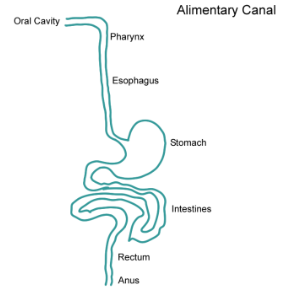
Gastrointestinal (GI) tract or, Alimentary Canal: "Tube" from mouth to anus.
-
Path of Digestion-All the parts
-Oral cavity (mouth)
-Pharynx (throat)
-Esophagus
-Stomach
-Small intestine
-Large intestine
-Rectum
-Anus
-
Accessory Structures (located in the mouth)
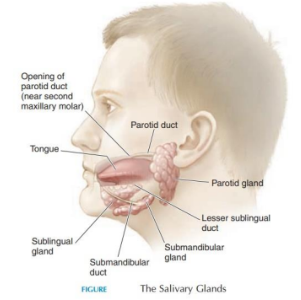
-Teeth
-Tongue
-Salivary glands
-
Accessory structures (located in the abdominal-pelvic cavity)
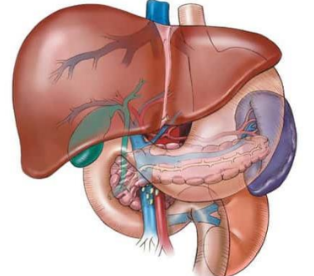
-Liver
-Gallbladder
-Pancreas
-
Oral Cavity components
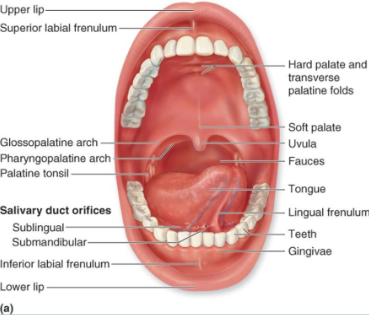
Entrance to the digestive system: the mouth
-Lips
-Cheeks
-Vestibule
-Teeth
-Tongue
-Hard palate
-Soft palate
-Uvula
-Salivary glands
-
Functions of the Mouth
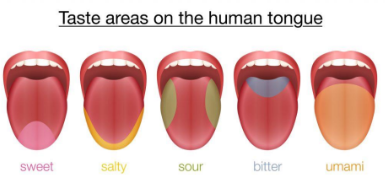
-Teeth begin the physical breakdown of food
-Salivary glands begin chemical breakdown of food
-Cheeks and lips hold food in mouth
-Taste buds detect flavor
-Tongue mixes food, saliva, and mucus
-A bolus is prepared for swallowing
-
Mechanical Digestion
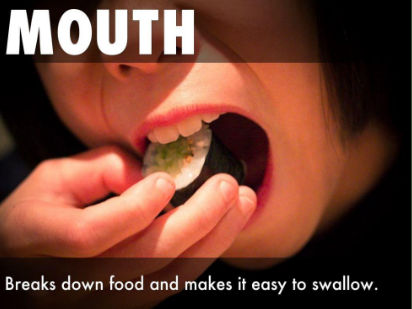
-Physical breakdown of food (mastication= chewing)
-
Teeth
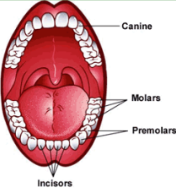
Four different types of teeth:
-Incisors: (4) anterior chisel shaped teeth for cutting
-Cuspids/Canines: (2) pointed incisors for piercing
-Bicuspids/Premolars: (4) lateral and semi-flat for grinding
-Molars: six posterior; flat for crushing and grinding
-
Chemical Digestion
-Chemical breakdown of food
-The mouth begins the process of breaking down carbohydrates with the enzyme salivary amylase.
-
Salivary Glands
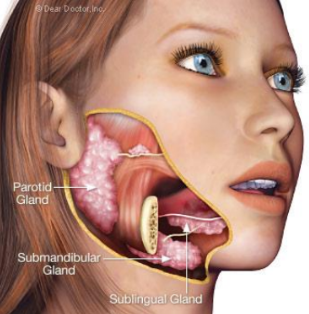
-Chemical digestion begins with salivary glands.
-----Parotid (mumps)
---Submandibular
---Sublingual
-
Saliva
Functions:
-Lubricates and moistens food
-Cleanse mouth and teeth
-Dissolve food so it can be tasted
-Helps bind food into a mass (bolus)
-Antimicrobial
Composition:
-Mostly water (99.5%)
-Salivary amylase
-Mucus
-
Deglutition (Swallowing)
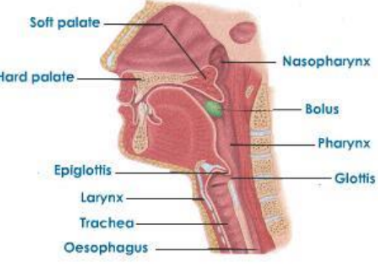
-Voluntary until food reaches oropharynx
-Reflex action as bolus is swallowed
-
Pharynx
Subdivisions:
-Nasopharynx:
---Posterior to nasal cavity
---Passageway for air
-Oropharynx:
---Posterior to soft palate
---Passageway for food and air
-Laryngopharynx:
--Superior to esophagus
--Passageway for food entering esophagus
-
Pharynx
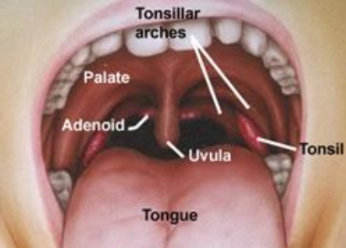
Tonsils:
-Nodules of lymphatic tissue that defend against pathogens
-Embedded in mucous membranes of tongue and pharynx
--Palatine
---Lingual
---Pharyngeal (adenoids)
-
Esophagus
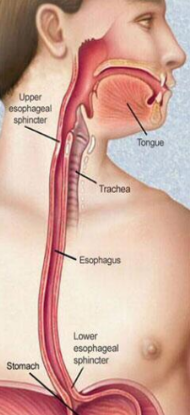
-Tube of smooth muscle from pharynx to stomach
-Lubricated with mucus
-Collapsed when empty
-Transports bolus using peristalsis
Divisions
-Upper esophageal sphincter
-Cardioesophageal (lower) sphincter
----Controls passage of food into stomach
---Acid reflux ("heartburn")
-
Stomach Functions
-Acts as a mixing chamber and holding reservoir
-Food digested in 2-6 hours and then exits through pyloric sphincter into duodenum as thick soupy liquid called chyme.
-Major site of food breakdown through mechanical and chemical digestion.
-
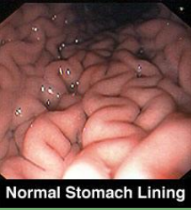
Features of the Stomach
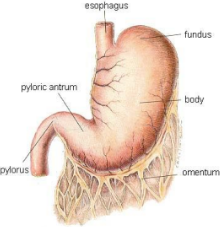
-Rugae: Deep folds allowing for stomach expansion
-Lesser curvature: Upper smaller curve of stomach; lesser omentum (mesentary) attached.
-Greater curvature: lower, larger curve of stomach; greater omentum (mesentery) attached.
-
Regions of the Stomach
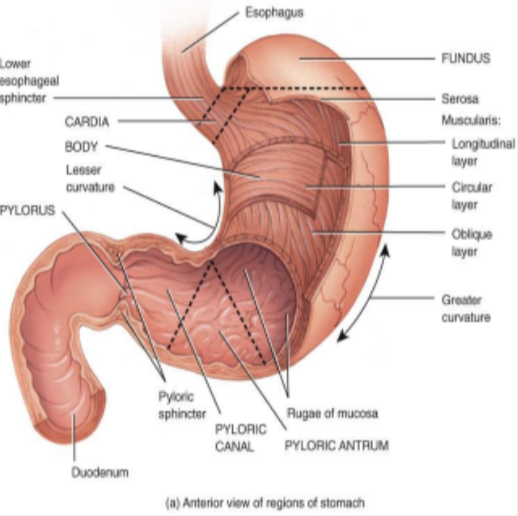
-Cardiac region: near the heart; food enters from esophagus through the lower esophageal sphincter.
-Fundic region: temporarily holds food
-Body: main region
-Pyloric region: lower region entering into the duodenum through the pyloric sphincter.
-
Mechanical Digestion- Stomach Functions
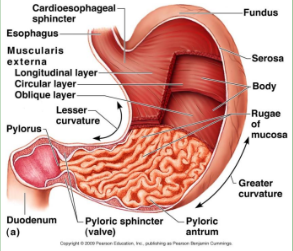
-Muscularis has 3 layers instead of 2.
-Complex movements are possible because of muscle arrangement
-
How big is the rectum of the large intestine? What are its functions? What does it include? Where does it open to?
-Last 20cm of large intestine
-Holding of feces
-Includes anal canal
-Opens at anus
-
What are the two anal canal sphincters? What muscle are they made of?
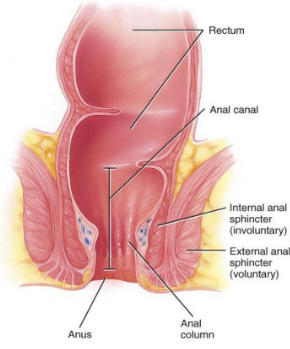
-Internal sphincter- smooth muscle
-External sphincter -skeletal muscle
-
The functions of the large intestine?
-Resorption of water
-Production and elimination of feces
---->Three-quarters water and one-quarter solids
--->Solid portion is undigested food (fiber; cellulose)
---->Symbiotic bacteria
-Causes odor and generates gas
-Make vitamins B & K
-
What are the accessory organs of digestion?
-Teeth
-Tongue
-Glandular organs= salivary glands, liver, gallbladder, and pancreas
-
Location of pancreas?
Deep in the abdominal cavity behind the peritoneum.
-
What kind of functions does the pancreas have? (two)
Endocrine and exocrine functions
-
Functions of Pancreas- Endocrine gland
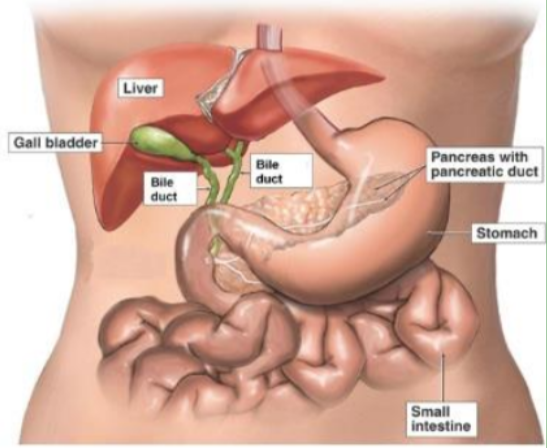
Functions to balance blood glucose/blood sugar
-
Functions of Pancreas- Exocrine gland
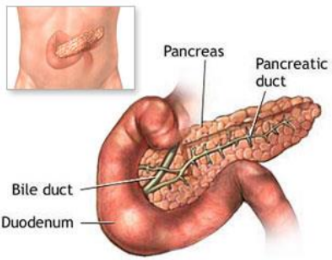
Functions to assist in digestion
-Neutralizes chyme
-Digestive enzymes for all types of food
-
Location of liver?
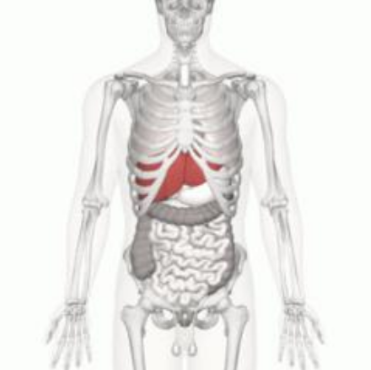
Located in the upper right quadrant just Inferior to diaphragm.
-
How many lobes does the liver have? What are they called?
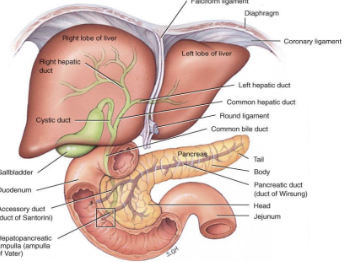
Two lobes
-Large right lobe
-Smaller left lobe
-
What are the lobes made up of?
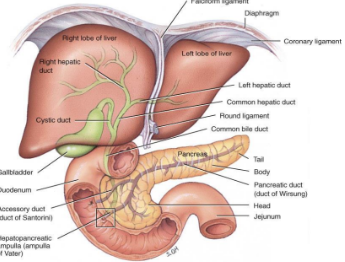
Functional units called lobules
-
What are the functions of liver?
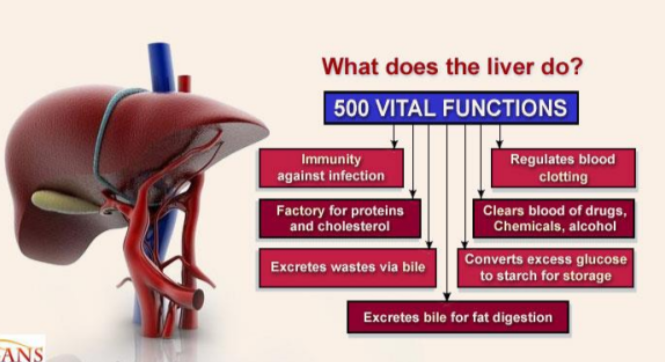
-Makes bile which emulsifies fats
-Stores glycogen (carbohydrate)
-Detoxifies poisonous substances
-
What is the Hepatic Portal System?
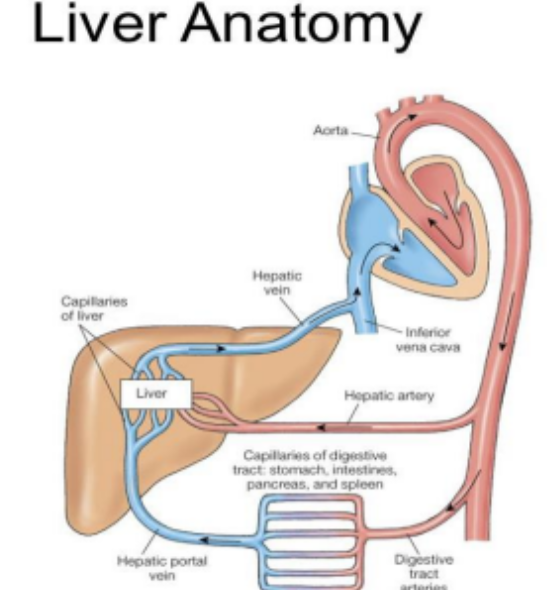
-A venous system that returns blood from the capillaries of the gastrointestinal tract through the liver to be filtered before returning to the Inferior vena cava.
-
What is the Gallbladder?
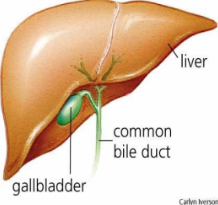
-Stores and concentrates bile
-
The process of the gallbladder?
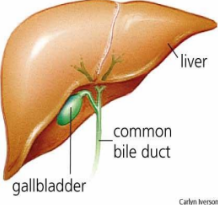
Bile exits gallbladder via cystic duct which joins Hepatic duct to form common bile duct which enters the duodenum.
-
Is the gallbladder necessary to have? What forms in the gallbladder?
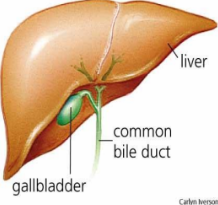
-Can do without it but have to change diet (lower fat)
-Gall stones can form here
-
Peritoneum
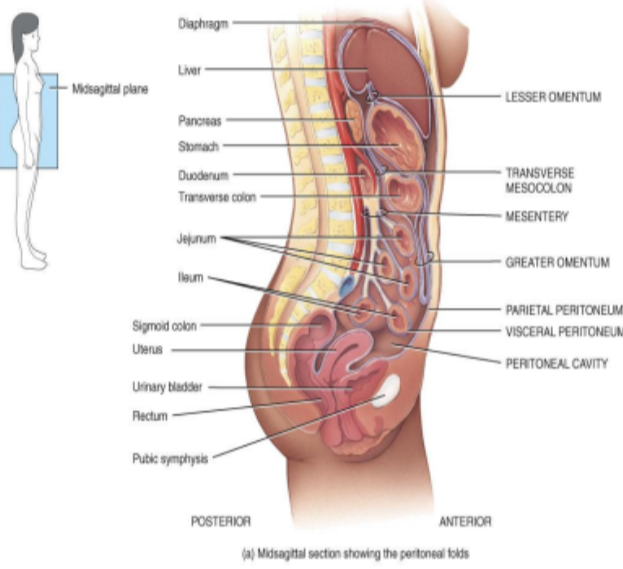
Serous membrane lining the abdominal wall and organs
-
Parietal peritoneum
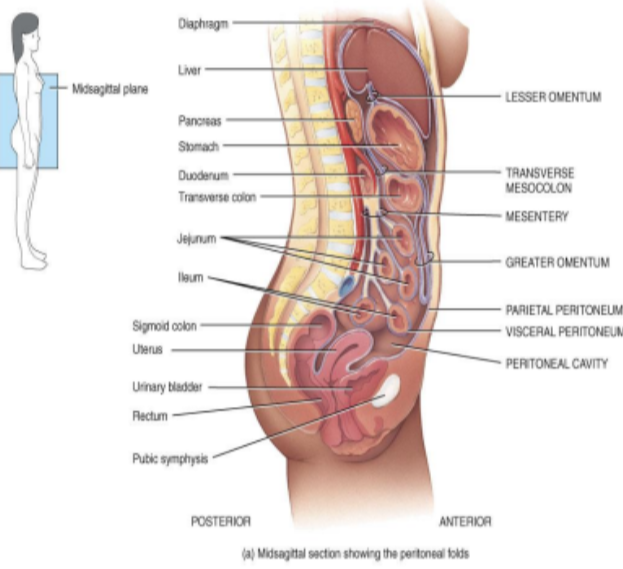
Lines wall of abdominopelvic cavity
-
Visceral peritoneum
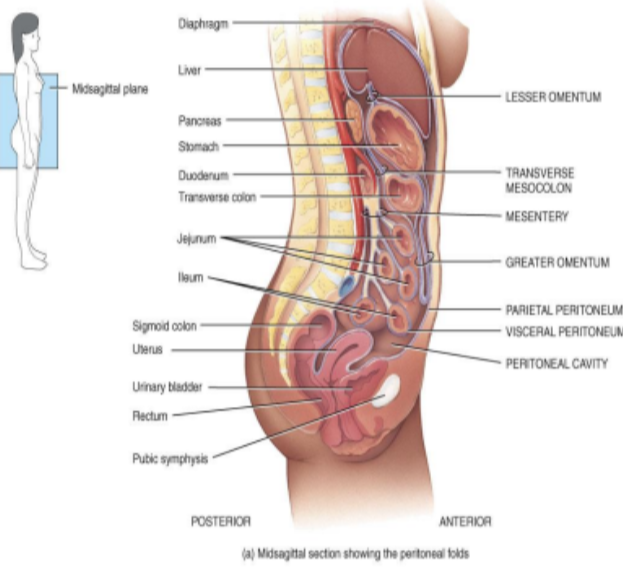
Covers some organs in cavity
-
Peritoneal cavity
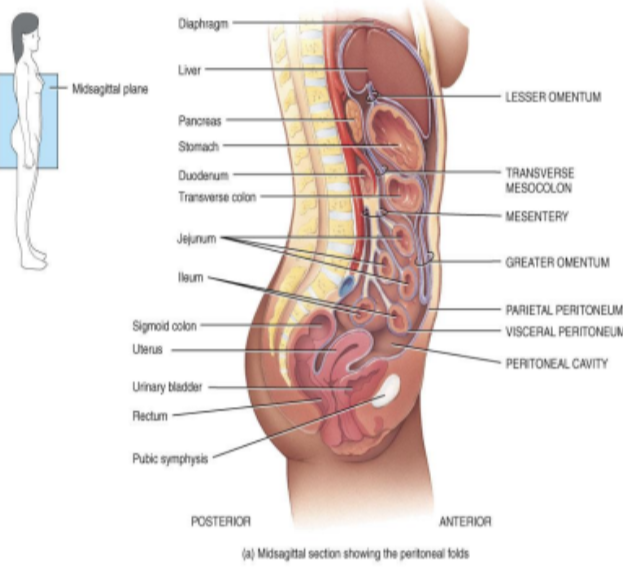
Contains serous fluid
-
Mesentary
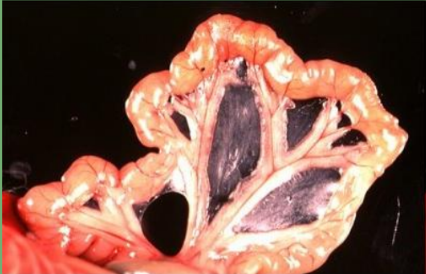
-Double-layered visceral peritoneum
-Includes greater and lesser omentum
-Supports visceral organs
-Contains blood vessels, nerves, lymphatic vessels
-
Small Intestine function?
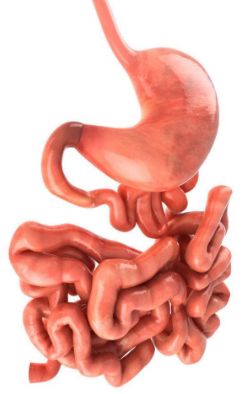
Absorption of digested food molecules
-
Small intestine extends from ____ to _____?
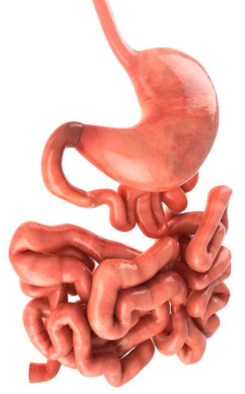
Extends from pyloric sphincter to ileocecal valve
-
Does the small intestine have a large diameter and short length?
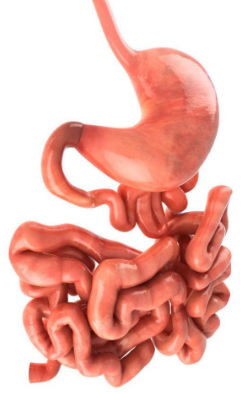
No, it has a small diameter but long length (~22ft)
-Surface area of a tennis court
-
What are the components that make up the surface area of the small intestine?
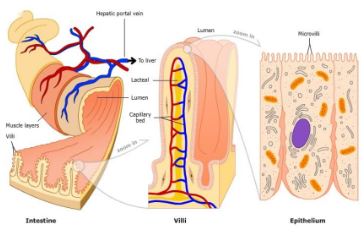
-Circular (or Mucosal) folds
-Villi
-Microvilli
-
Circular (or Mucosal) folds
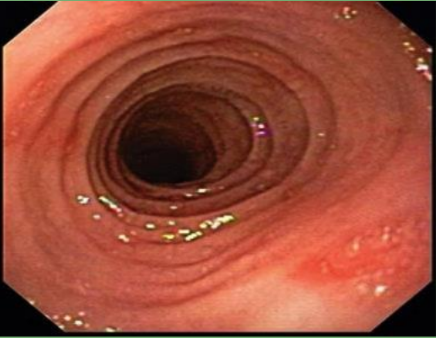
Permanent, transverse folds
-
Villi
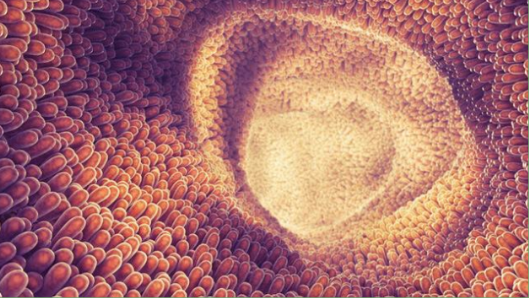
Finger-like projections of mucosa
-
Microvilli
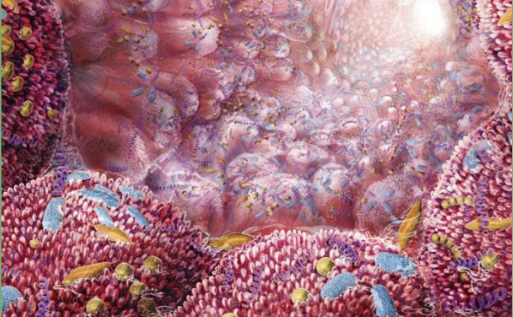
-Microscopic extensions of columnar epithelial cells
-
Regions of Small Intestine?
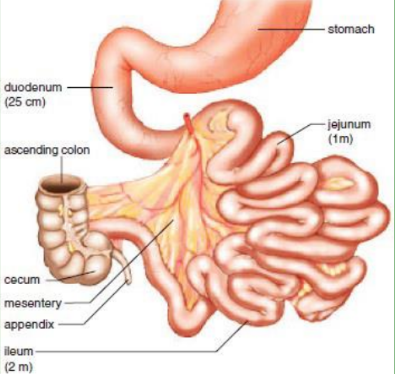
-Duodenum
-Jejunum
-Ileum
-
Duodenum
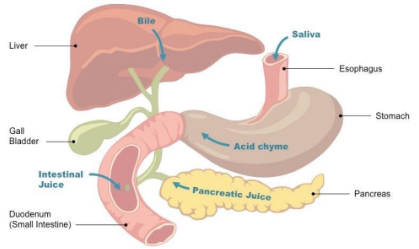
-First 10 inches of small intestine
-Receives secretions from pancreas and bile from liver
-Emulsification of fats; neutralize chyme
-
Jejunum
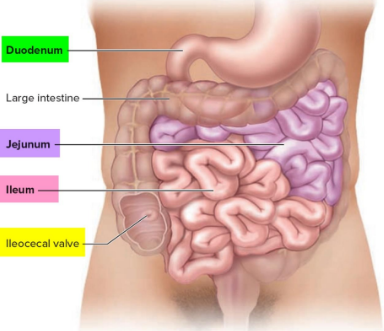
Middle section of small intestine (~3ft)
-
Ileum
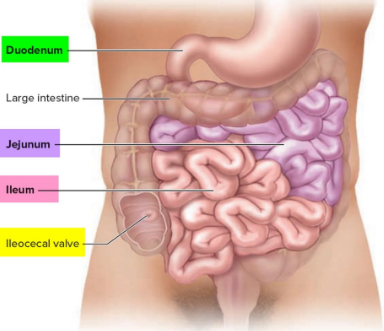
-Final 6-7ft
-Enters large intestine at the ileocecal valve
-
Micturition
Urination
-
Terms for "chewing" and "swallowing"
Chewing= mastication
Swallowing= deglutition
-
What is "emulsification" and where does it occur in the digestive system?
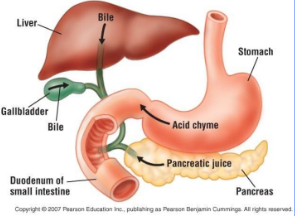
Emulsification is the breakdown of fats which occurs in the duodenum.
-
Excretion
Elimination of byproducts of cellular metabolism from the body.
-
Food in the mouth which has been mechanically and chemically digested and then formed into a ball to be swallowed is called a _______.
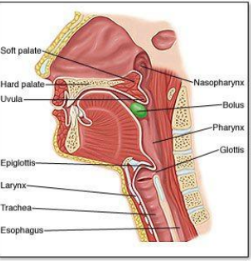
Bolus
-
What is the enzyme secreted by the salivary glands that digests starches?
Salivary Amylase
-
Name the salivary glands.
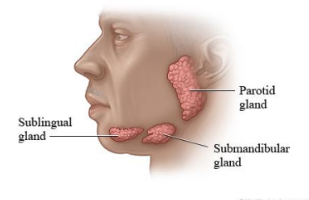
-Submandibular
-Sublingual
-Parotid
-
Name four types of teeth
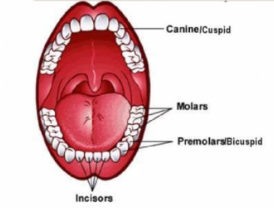
-Incisors
-Cuspids/Canines
-Bicuspids/Premolars
-Molars
-
What is the term used to describe food digested by the stomach?
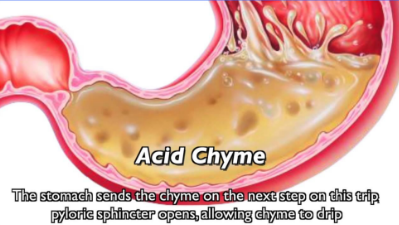
Chyme
-
Name the two sphincters in the stomach
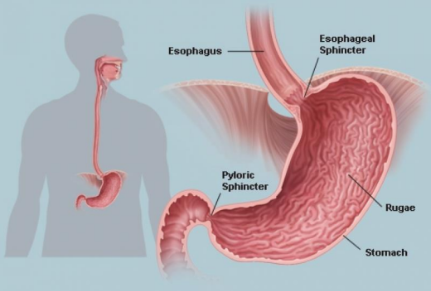
-Cardioesophageal
-Pyloric
-
The stomach ling has folds called ______, which are covered in a layer of protective ________, that prevent ________ from forming.
-Rugae
-Mucus
-Ulcers
-
How many muscular layers comprise the wall of the stomach? Name the layers.
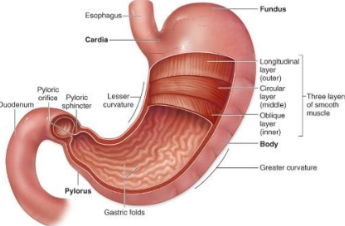
Three
-Longitudinal
-Circular
-Oblique
-
Name the membrane attached to the stomach that covers the visceral organs and the part of the stomach where it is attached.
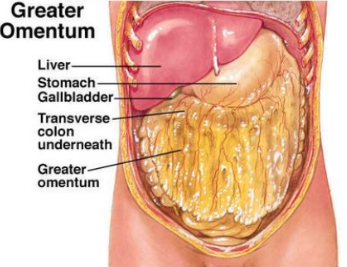
Greater omentum
-Attached to the Greater Curvature.
-
What is the function of the small intestine?
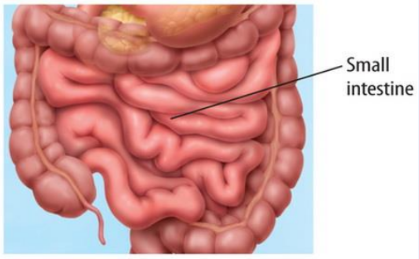
-Absorption of nutrients
-
The small intestine extends from the _______ sphincter to the ________ valve.
-Pyloric sphincter
-Ileocecal valve
-
Name the three sections of the small intestine.
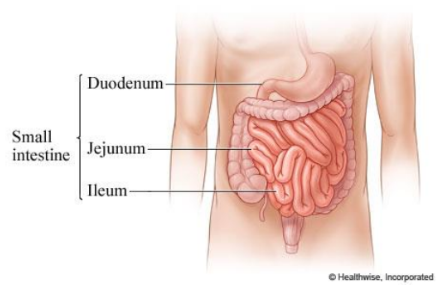
-Duodenum
-Jejunum
-Ileum
-
The small intestine is small because of its _______, but it has a lot of surface area from _______, _________, and _________.
-Diameter
-Mucosal folds
-Villi
-Microvilli
-
Name the location where fats are emulsified and two accessory structures that produce substances which contribute to this.
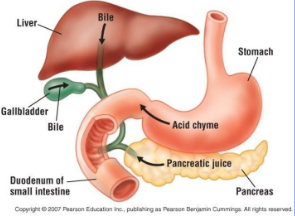
-Duodenum
-Liver (Gall Bladder) and Pancreas
-
Carbohydrates are broken down in the mouth by what enzyme?
Salivary amylase
-
Fats are broken down in the stomach which continues in the small intestine. They are broken down by an enzyme called _______ in the stomach. And also another enzyme called ______ in the duodenum of the small intestine.
Pepsin. Lipase is an enzyme the body uses to break down fats in food so they can be absorbed in the intestines.
-
What are lipids broken down by and where are they broken down?
Lipases break down the lipids into fatty acids an glycerides. These molecules can pass through the plasma membrane of the cell, entering the epithelial cells of the intestinal lining.
-
What are nucleic acids broken down by and where are they broken down?
Nuclease enzymes. They are broken down in the small intestine.

